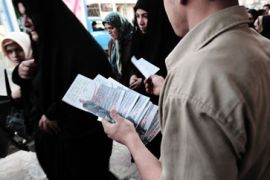Iran’s elections explained
Voters have to choose between a confusing range of fluid political coalitions.

 |
| Iranians have a confusing collections of factions and coalitions to choose between [AFP] |
Iran does not have political parties along Western lines, rather a confusing collection of factions which come together ahead of elections.
There is also some degree of overlap between the four main groups taking part in the vote, meaning that that a candidate can stand for parliament on the list of more than one of them.
| The Conservatives |
Iran’s conservatives call themselves “Principalists” to emphasise their loyalty to Islam and especially the vision of clerical rule set out by Iran’s revolutionary leader Ayatollah Ruhollah Khomeini.
However they do not form a homogenous group and Ahmadinejad’s presidency has highlighted splits between conservative politicians.
United Principalists Front or Jebhe-ye Mottahed Osulgarayan
The main conservative faction contains the Sweet Scent of Service (Rayehe Khosh Khemdat) faction of parliamentarians loyal to Mahmoud Amadinejad, the president. It is the closest thing he has to a political party.
It also includes the majority of the other conservative factions, such as the Followers of Imam and Leader’s Line and the prominent Islamic Engineers Group.
Broad Principalists or Etelaf-e Faragir Osulgarayan
A seemingly rival list of conservative candidates who have been more criticial of Ahmadinejad’s policies.
However the coalition insists that it is independent.
Around one third of its candidates in the capital are shared with the other conservative factions, meaning there is a considerable overlap between the two coalitions.
| The Reformists |
Reformist Coalition or Etelaf-e Eslahtaleban
The coalition is said to have been inpired by Mohammad Khatami, former president and champion of Iran’s reformist movement. The reformists have been pushing for the liberalisation of the economy and culture as well as cautious social reforms.
Its hopes of challenging the conservative dominance of parliament have been hit by the disqualification of hundreds of its candidates during the official vetting process and it is now contesting just 120 of the 290 seats.
The coalition is made up of 30 parties, including Khatami’s Militant Clerics League and the Islamic Iran Participation Front, the leading reformist party.
The Executives of Reconstruction Party is also part of the coalition. Allies of Akbar Hashemi Rafsanjani, the pragmatic former president, they are not strictly speaking reformists as their main focus is on economic development. However, they share a distrust of Ahmadinejad.
National Confidence Party or Etemad-e Melli
Led Mehdi Karroubi, the former parliamentary speaker, the National Confidence Party is the closest Iran has to a Western-style political party and runs a newspaper of the same name.
Karroubi, who is expected to run in the 2009 presidential polls, has been at pains to keep his party’s independence and ensure it is not swallowed up into the main reformist current.
About 80 per cent of its candidates in the provinces are shared with the reformist coalition but the figure is less than 50 per cent in the capital Tehran.
With 160 candidates standing, the party’s list emerged in slightly better shape after the vetting process than that of other reformists, but only just.
In a sign of some overlap with conservatives, two of its Tehran candidates are also on the Broad conservative list.